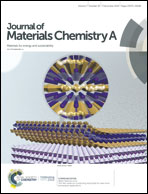Zr vacancy interfaces: an effective strategy for collaborative optimization of ZrNiSn-based thermoelectric performance†
Abstract
Grain boundaries play a key role in carrier/phonon transport in thermoelectric materials. Precise regulation of the chemical composition of the grain boundaries by conventional methods is a huge challenge. Here, the method of atomic layer deposition (ALD) is used to precisely control the Zr vacancy ratio and the ZrO2 nanoparticle content in the grain boundary of the ZrNiSn0.99Sb0.01 (ZNSS) thermoelectric material. First-principles calculations show that the Zr vacancy interface not only introduces the Zr/Sn anisite defect, but also optimizes the interface barrier, which strongly decouples the Seebeck coefficient and electrical conductivity to achieve a substantial improvement in electrical performance. Benefiting from the optimization of the Zr vacancy interface for electrical transport, the highest power factor of 56.1 μW cm−1 K−2 is achieved at 873 K. At the same time, the multi-scale microscopic effect induced by the Zr vacancy interface and ZrO2 nanoparticles can greatly suppress the lattice thermal conductivity. The maximum zT value of 1.13 is achieved, which is 35% higher than that of pure ZNSS. Our work puts forward a new idea of interface engineering for enhancing the thermoelectric performance of ZrNiSn-based materials based on ALD technology, which may be of great significance for the design of high performance thermoelectric materials.



 Please wait while we load your content...
Please wait while we load your content...